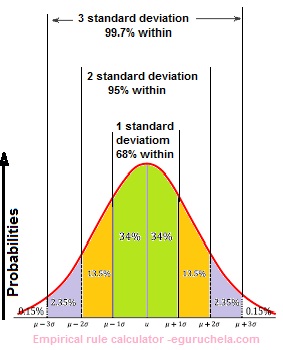Empirical Rule Calculation
Find the Empirical rule for the given set of data using this calculator.
Empirical rule is the statistical rule for a normal distribution determined with the mean and the standard deviation.
According to it, 68 % of data falls within first SD, 95 % within first two SD and 99.7 % within first three SD's.
Hence it is also known as 68-95-99.7 or three sigma rule.
The empirical rule works because it allows to estimate probabilities very quickly when someone dealing with a normal distribution.
We often create ranges using standard deviation, so knowing what percentage of cases fall within 1, 2 and 3 standard deviations can be useful.

The empirical rule referred as three-sigma rule or 68-95-99.7 rule, it is a statistical rule which states that for a normal distribution, almost all observed data will fall within three standard deviations (denoted by σ) of the mean or average (denoted by µ).
The empirical value is :
a. derived from or relating to experiment and observation rather than theory,
b. based on practical experience rather than scientific proof and
c. (Philosophy) a (of knowledge) derived from experience rather than by logic from first principles.
Empirical means “based on observation” : The empirical rule come from observations. The Normal/Gaussian distribution is the most common type of data distribution. All of the measurements are computed as distances from the mean and are reported in standard deviations.
